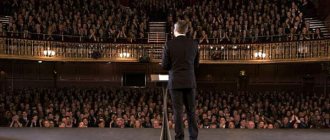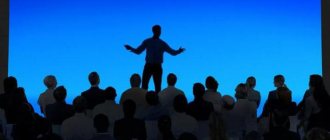Introduction
One of the highest talents is, nevertheless, the ability to influence people. Oratory has a lot of important meaning: measuring the world understanding of the people who are listening in a particular area, as well as influencing the actions of listeners. And, precisely in connection with this, this topic is relevant.
One of the most ancient philological sciences is rhetoric. Its warehouse was formed in Greece in the 4th century BC.
The main content of this science is the theory of argumentation in public speech. Even then, the outstanding philosopher Aristotle defined such science as “the ability to find possible methods of persuasion regarding each given subject.”
In ancient times, rhetoric was divided into the following sciences:
1. logic;
2. ethics;
3. physics.
This talent dates back to ancient times. It is also necessary to note the fact that there is a colossal number of historical events that could not have come true if there were no people who directed their development in a specific direction.
In ancient times, the Greeks loved to talk and listen just as much. We can say that the whole life of this people passed in endless conversations. The Greeks managed to transform public performance into something more: into an art that can be compared to both dance and music. Each nation brought something new, something of its own to art. So, for example, the Romans introduced severity, and the Malaysians - pomposity.
There were also times when the art of oratory was so valued that people who mastered it were carried in their arms. But it’s worth noting that much more often it was the other way around: people were punished for speaking correctly.
Unfortunately, we will never have the opportunity to enjoy the magnificent speech of Demosthenes, the sermon of John Chrysostom, and even what Copernicus said last before making the statement that the planet rotates.
The true art of an orator can only be observed by those who are close to him. Such talent, in this case, can be compared with the theater: “everything disappears when the curtain closes.” However, if in the theater a speech delivered in a timely manner has limitations - applause, then in oratory such a speech can turn everything upside down.
Purpose of the work: to study such a topic as the culture of oratory.
Objectives of this essay:
- identify the structure of this art;
- determine its types and genera;
- determine functional and semantic types of speech.
Structure: this work consists of ten chapters, three of which are structural elements (introduction, conclusion, list of references), and seven chapters are the main part, the fourth chapter includes two paragraphs. The total volume is twenty-five pages.
Two ways to develop speaking abilities
Every person without serious speech pathologies is capable of learning rhetoric; all it takes is time and perseverance. Perhaps the only quality that does not contribute to mastering the art of oratory is laziness.
Honed eloquence skills play into our hands in different areas of life and situations: during an interview, project presentation, answering an exam, when delivering ceremonial speeches, reports, etc.
There are 2 ways to master rhetoric:
- Regular self-study will help you master the skills of oratory, as they once helped even the tongue-tied Demosthenes. First of all, this is work on the technique and culture of speech. The more you practice in front of a mirror or phone camera, the freer, cleaner and more harmonious your monologues will be. What you can work on at home: Practice calm, measured breathing, low speech rate, lively intonation without falsehood.
- Develop the strength of your voice and clear diction.
- Learn to work with texts: paraphrase the content of small passages in your own words, concentrating the meaning in one sentence;
- look for key phrases in the texts and formulate them in your own way;
- retell what you read, highlighting only the most important things.
Types and types of oratory
The genera and types of this art were not formed immediately, but gradually. These divisions are distinguished based on the spheres of communications, which, in turn, correspond to one of the main functions of speech, namely:
- impact;
- message;
- communication.
In the real practice of public communication, there are types of oratory. So this is:
- socio-political eloquence;
- judicial eloquence;
- social and everyday eloquence;
- spiritual (church-theological) eloquence.
Such eloquence as socio-political includes speeches whose themes are either socio-political, or socio-economic, or socio-cultural, or ethical-moral.
There is academic eloquence. This is a certain type of speech that helps to form a scientific worldview, which, in turn, has distinctive features - scientific presentation, logical culture, as well as deep argumentation. Academic eloquence can include a scientific report, a scientific message, and both a university and popular science lecture. This type of speech has many similarities with the scientific style of speech. However, in academic eloquence, expressive means are very often used.
Social - everyday eloquence. This genus includes the following:
- greeting speech;
- speech given at diplomatic receptions;
- table speech;
- anniversary speech (this can be delivered both to a specific person and to a significant date).
Judicial eloquence. This type of speech exists in order to influence the court purposefully and also effectively. Judicial eloquence contributes to the formation of exhortations of judges, as well as those who are present in the room at that moment. Judicial eloquence is also divided into:
- defensive speech;
- prosecutor's speech;
- lawyer speech;
- accusatory speech.
Spiritual (church-theological) eloquence. This genus is considered the most ancient; it has its own traditions, as well as rich experience. Highlight:
- official speech is a speech that is delivered to people serving the church or other persons interacting with official action;
- A sermon is a speech that is delivered to people coming to church, and it must also be accompanied by church actions.
Inter-style, as well as general linguistic means - this is the base that underlies any kind. But it is necessary to note that any kind of oratory has its own specific linguistic features that form a microcircuit with the same stylistic coloring.
What is a speech genre? Definition of speech
The general concept of speech is interpreted by linguistic dictionaries and reference books as the activity of a speaker using language aimed at interacting with other participants in a given language group, using different means of speech, the purpose of which is to convey complex content, including information aimed at the listener and encouraging him to act or I will answer. Speech flows in time and is expressed in audio (including internal) or written form. The result of such activity is recorded in memory or writing. In modern practice, oratory goes beyond the scope of poetic eloquence, as it was in antiquity. The genre of speech is determined by purpose and means. Each type of performance has its own genres, which over time have been classified into areas and styles. This is a cultural form of speech, a stable type of utterance that has a thematic, stylistic and compositional nature.
The role of functional styles of literary language
An oratorical speech can only be prepared. Preparation takes place using book and written sources, which, in turn, significantly influence both directly and directly on the structure of speech.1
The informative function underlies the official business style. This style of speech serves the sphere of relationships that are officially business.
Functions such as reporting and evidence of information are at the core of the scientific style. Sphere of scientific knowledge.
The journalistic style is based on functions such as message, as well as impact. This style of speech serves both the sphere of socio-political, and the sphere of socio-cultural, and many other social relations. In a journalistic style, absolutely all means that are linguistic can be used. This style is characterized by economy of linguistic means.
The artistic style is based on functions such as impact and aesthetics. In this style, the national language and literary language are most closely reflected.
Theological and official styles
The church-theological style of oratory includes types of speech genres, including sermons, greetings, obituaries, conversations, teachings, messages, lectures in religious educational institutions, speeches in the media (by clergy). This genre is special: the listeners are usually believers. The topics of speeches are taken from the Holy Scriptures, the works of the church fathers and other sources. They perform in a genre that has features of formality, business and scientific styles. The basis is a system that requires the availability of official documents. Such speeches are aimed at analyzing the situation in the country, world events, the purpose of which is to highlight specific information. They contain political, economic and other similar facts, assessments of events, recommendations, and progress reports. As a rule, they are devoted to current problems or contain appeals and explanations of theoretical programs.
Functional and semantic types of speech
The composition of oratorical speech is not homogeneous. This is due to the fact that a person, when thinking, reflects a variety of connections between objects, between phenomena of reality, between events, as well as between individual judgments. There are such types of speech as: 2
- description;
- narration;
- reasoning.
And it is in these styles of speech that these connections are expressed. In this regard, the oratorical speech appears to us:
- monologue narration;
- monologue reasoning;
- monologue narration
Narration is a type of speech that reports on states, as well as actions that develop in a time sequence. In addition, they have their own linguistic means. 3This type of speech is characterized by such a feature as dynamics.
Based on the fact that this type of speech includes situations that have dynamic reflections, this mechanism determines its position in speech.
With the help of verbs, the dynamics of this type of speech are created. Very often, verbs of a specific action are used because they have the ability to express both the sequence of events and their rapid change. It should be highlighted:
- specific narrative;
- generalized narrative;
- informational storytelling.
Description is a type of speech that gives an idea of character, gives a statistical picture, an idea of the structure, an idea of the qualities of an object, of properties by listing features both essential and not essential at a certain moment.
This type of speech, such as description, is also divided into:
- statistical;
- dynamic.
Reflection or reasoning is a type of speech in which the internal characteristics of both phenomena and objects are revealed, specific provisions are proven, and, naturally, the study of phenomena and objects is carried out.4 Those judgments that are included in reasoning have special logical relationships with each other , this is what characterizes this type of speech. Such logical judgments form either one conclusion or a series of conclusions on a specific topic.
By its very nature, oratory is controversial. This is due to the fact that it reflects the contradictory conflicts of communication and current life. There are two types of disputes:
- implicit (or hidden, internal);
- explicit (or open, external).
Controversy is communication that takes place in public, masters of speech, an argument in the process of discussing a specific issue.
Speakers can argue a lot; during disputes, they use all the means freely available from the huge arsenal of polemics. This includes irony, allusions, sarcasm, and antithesis, as well as numerous omissions, remarks, comparisons, and relief.
Selection and use of language means
In this case, the topic and purpose of the speech are primarily important. Some political speeches are characterized by stylistic features that characterize the official style, which implies impersonality or its weak manifestation, bookish coloring, political vocabulary, and special terms (for example, economic). These features characterize the features of the speech genre and determine the use of means (visual, emotional) to achieve the desired effect. For example, at a rally the report is of an appealing nature, but it is carried out using colloquial vocabulary and syntax. A striking example is the speech of P. A. Stolypin “On the right of peasants to leave the community” (delivered in the State Council on March 15, 1910)
Speaker and his audience
In order to successfully speak in front of a large crowd of people, the speaker needs, first of all, to attract the attention of absolutely the entire audience, it is necessary to force people to listen to himself. 5At first glance, it may seem that controlling such a mechanism as listener attention is very simple. However, it is not. A performance that will bring success depends on the abilities of the speaker, on his professionalism, preparedness, and on those factors that he cannot influence in any way.
The problem of genres according to Bakhtin
The relationship between generally accepted (folk) and individual styles is a problematic issue of expression. In order to study style well, it is necessary to responsibly approach the issue of studying the genre (speech). Bakhtin said that speech can actually exist only in the form of specific utterances of individual speaking people (subjects). Speech genres form the basis of his concept of views on speech as a real unit of communication. According to Bakhtin, speech is cast in the form of an utterance and cannot exist without it. The change of speech subjects is the first feature of an utterance. The second is completeness (integrity), which has a connection with:
- subject-semantic exhaustion;
- speech intention (the will of the speaker);
- forms of completion typical of the composition and genre of completion.
The genre of the planned utterance influences the choice of vocabulary. MM. Bakhtin attaches great importance to genre forms. Thanks to genre recognition, from the very beginning of communication we have a sense of the speech whole. Without this, communication would be difficult and almost impossible.
4.2. Techniques for establishing contact with the audience
Contact with the audience is the highest manifestation of public speaking skill. This community can arise on the basis of common mental activity, on sensory experiences that are similar. The speaker will receive a response from his audience if he shows his own attitude to the subject of speech, as well as the interest and conviction of the speaker. It is also very important that you need to feel your listeners, and it is also necessary to put into practice the ability to correct speech depending on their reaction. The speaker must be able not only to argue on some topic, but also have a huge range of knowledge on numerous issues.
A positive reaction to what the speaker says, “working” silence in the hall, as well as the listeners’ posture, the audience’s gaze, head nods, exclamations of approval, laughter, their smiles and applause - all these are the main indicators between communicators. Contact is a quantity that is variable, that is, it can be complete (with the entire audience) or incomplete, stable or unstable at various stages of speech delivery.
Eye contact must not only be established, but also constantly maintained with the audience. This is necessary in order to win the audience. The person who speaks, as a rule, slowly glances at absolutely all the listeners.
Before you begin your public speech, you need to take a short psychological pause. This pause lasts from five to seven seconds. The speaker’s speech should not be monotonous or monotonous. Phrases must be separated by pauses, and must also be pronounced with different intonations.
Today's oratory is characterized by a combination of such linguistic means as emotional - figurative, as well as logical - analytical.
The attention of listeners tends to become dull, and this does not depend on how interesting a particular topic is to the audience. There are a number of oratorical techniques to maintain the attention of listeners:
- Question and answer reception. The speaker himself asks questions and gives answers to them, clarifies the doubts raised, as well as objections, and comes to specific conclusions;
- Such a technique as the transition to dialogue from a monologue introduces participants to the process of discussing any topic, and also includes their interest;
- Creating a situation that is problematic. "Why?" - this is exactly the question that the created situation should pose to the audience. Thanks to this, their cognitive activity is stimulated;
- There is another technique that literally forces listeners to think and speculate. This technique is called the “reception of novelty of information”;
- The next technique is based on personal experience, on personal opinions, on what has always been and will be interesting to the listener;
- “Demonstration technique”: how significant is practical information;
- The same technique gives the audience a “break,” that is, it is necessary to deviate a little from the topic;
- This technique is called “quiet voice”. With its help, it is not at all difficult to draw attention to important places in the speaker’s public speech. It is necessary to simultaneously slow down and lower the strength of the voice;
- This technique is called the “gradation technique.” That is, this is an increase in the semantic and emotional significance of the word. This technique can help both strengthen and give emotional expressiveness to both a formulated thought and just an ordinary phrase;
- Reception of inversion. This technique is a figure of speech. Such a turn can turn the generally accepted, common course of expressions and thoughts into the opposite direction;
- This technique is called “the technique of appealing to one’s thoughts.”
Next, what I would like to note are lexical techniques due to the fact that they significantly increase the persuasiveness of oratorical speech. Tropes are what the manuals for a given art recommend for use in oratory.
Trope - (from the Greek tropos - turn, turn of speech) the figurative meaning of the word, that is, the expression of words, phrases in a figurative meaning. If we take this term in a narrow view, then it is a word transformation, with the help of which one can achieve the aesthetic effect of expressiveness in speech. The trails include the following:
- comparisons;
- metaphors;
- epithets;
- allegories;
- hyperboles and others.
Metaphor: using this technique, the name is transferred from one object to some other object. This is a speech rapprochement of two phenomena due to either similarity or contrast (“The locomotive of history cannot be stopped...”).
Comparison: this technique is popular in use, it is used much more often than all others because it is with the help of this technique that the speaker can achieve the result that was intended. Comparison is endowed with colossal persuasive power; it is capable of activating both figurative and associative thinking of listeners.
Epithet: this technique allows you to reveal the essence of an object or phenomenon by defining it figuratively (“A student is not a vessel that should be filled with knowledge, but a torch that needs to be lit!..”).
Hyperbole: with the help of this technique, the properties or qualities of phenomena or objects are deliberately exaggerated (“A rare bird will fly to the middle of the Dnieper”).
Allegory: this technique is capable of allegorically depicting something (“Once a passer-by asked a builder: “What are you doing?” He thought and answered: “Don’t you see? I’m carrying stones.” The second builder answered the same question: “I’m making money!” ).
It should be noted that in a speech it is best to pay attention to short sentences, as they are much better remembered and also better perceived. In addition, such proposals allow a more varied approach to changing intonation.
The means that were listed above serve not only to unite the audience and the speaker, but to overcome the so-called “barrier”.
Dialogue in speech genres
The dialogue is accompanied by the mandatory use of “paralinguistic” means necessary for the oral speech genre. Everyday dialogue is the sphere of “mixed” speech, which realizes the function of communication in inextricable connection with non-linguistic means. A characteristic feature of communication through speech is the dialogical principle. This means that communicative roles are in an alternating state (roles are changing). Formally, it looks like this: one speaks, the other listens. But this is an ideal scheme, which is practically never implemented in its pure form. The listener often remains passive or fills pauses with facial expressions and gestures (paralinguistic means of communication). Features that characterize everyday dialogue:
- unplanned;
- a wide variety of issues in discussion;
- quick change of topics;
- conversational style;
- lack of targets;
- emotionality and expressiveness.
Learn public speaking. This is very important in our life!
Main types of arguments
By presenting arguments that cannot be argued with, the speaker must convince the listener of the truth of the statements that, in turn, have been put forward by him.
An argument is a logical, irrefutable argument that serves as the basis for proof. 6The correctness of the arguments has been tested and proven by practice, so the argumentation convinces listeners of the correctness of the provisions expressed by the speaker.
There are various arguments. In such a science as rhetoric, the following are distinguished:
- Arguments to the merits of the matter - in this case, the arguments will be those factors that were ultimately obtained from observations, documents, material, both statistical and digital, and so on.
- Arguments to a person: have impacts that are emotional on the audience.
In oratory practice, arguments to a person are used no less often than arguments to the essence of the matter. In fact, the arguments to a person are very diverse, there are quite a large number of them, but I would like to note the following:
- an argument for pity, that is, this is done in order to evoke pity, a feeling of compassion among opponents and thereby persuade them to one’s side;
- argument to the individual: the speaker puts his opponents in a negative light, thereby setting his listeners against them; all this is done by changing the subject of discussion;
- argument to vanity, that is, they praise opponents in order to soften their opposition;
- argument to the public, that is, the speaker tries to turn his audience only towards himself and confront opponents;
- arguments to authority, that is, the speaker refers to the opinions of outstanding scientists, writers, figures, if their position coincides with the position of the speaker.
Such arguments may not always be correct, and it is on this basis that they should not be recommended to current speakers. However, there is an exception - this is an argument to authority; This argument very often finds its application in academic speeches, as well as in scientific reports.
But, despite all of the above, it is necessary to take into account the fact that there are also statements that cannot be accepted as true (this is not an indicator that the author of such a statement is an outstanding scientist, thinker or activist). When referring to them, the author must be extremely careful.
The ability to speak beautifully: who needs it?
Oratory skills are necessary for people who often have to speak in front of large audiences. First of all, this applies to lawyers, teachers, managers, and coaches. Specialists in other fields may also need the ability to speak beautifully. For example, this will be useful for a businessman when negotiating with a potential partner’s team. And for the guide - for more free excursions.
Interesting: “He who cannot speak will not make a career” (Napoleon Bonaparte).
Oratory skills will also be useful in everyday life. Rhetoric courses can teach you to communicate easily, naturally, and make a positive impression on your interlocutor. People who have passed them are not afraid of awkward pauses during a conversation, boldly use gestures, and know how to convince the listener.
Speech preparation and presentation
There are three interrelated questions that the speaker faces:
- How to say?
- Where to say?
- What to say?
The process of developing a speech begins with understanding the topic of your speech, its main idea. Relevance, interestingness, specificity, accessibility - all these qualities should be possessed by the chosen topic. The title of the lecture is also important, since it should not only intrigue the future audience and attract their attention, but also reflect the entire content of the speaker’s speech.
What I would like to tell you about the goal: it is necessary to clearly outline it - the speaker not only tries to form in his audience specific beliefs and ideas that determine their further behavior, but also conveys information to the audience, talks about any facts or events. Whatever the speech, it must have an educational purpose, that is, the speaker, to the best of his ability, must introduce his audience to his own moral interests. This process should take place unnoticed by the listeners.
Imagining how the audience will perceive the speech and what will be incomprehensible to them is an integral part of preparing a public speech. The speaker is obliged not only to know, but also to take into account the composition of his future listeners. If the speech is not given to all listeners in general, but to a specific group of people who have their own goals and interests, then the effectiveness of the speech will increase noticeably.
Composing the speech itself, working on factual and theoretical material is the next stage, that is, it is necessary to formalize the speech compositionally and stylistically.
In order to study the material, you can turn to manuals, dictionaries, reference books, and so on.
After the material has been studied well, as a rule, they write either a summary of the text of the speech, or its outline, or the entire text, or theses.
Performance methods:
- reading text;
- reproducing it from memory with reading individual fragments;
- free improvisation.
In what cases is the text read? So, let's look at them:
- if it represents an official statement, the form and content of which cannot be deviated from;
- if the speaker is “out of shape”;
- if the material is large and completely new to the speaker.
When a speaker reads his speech and the audience's reaction gets out of control, it is very tiring. The failure of speakers is due to the fact that when reading a text “from a piece of paper” the speech becomes the same (monotonous), fast, and this quickly begins to tire the audience.
Before starting his public speech, the speaker needs to carefully prepare his speech to the smallest detail. It is necessary to correctly determine the topic, purpose, and title of the public speech, while taking into account both the composition of the audience and the situation. After this, you need to draw up a plan, select both theoretical and factual material. Rehearsal is a part that is considered necessary during preparation; it is impossible to do without it. Attention should be focused on pronunciation technique, but other aspects should not be left in the shadows during preparation.
At the final stage of preparing for a public speech, it is necessary to analyze it more than once, take into account such aspects of the speech as strengths and weaknesses, and already in the audience, when addressing your listeners, rely on the positive.7
Let's start with the basics: features, properties of public speaking
Oratory is a type of speech used by a speaker to present material to a large audience. Its key difference is interaction with absolutely all listeners. The speaker sees everyone, pays attention to everyone. The vast majority listen to his speech.
Interesting: It is impossible to call a teacher giving a lecture to which several students are listening a speaker.
Oratory also differs from a regular speech in several ways:
- Structure of speech. The speaker expresses thoughts using words, facial expressions, and gestures. The material itself is presented with intonation accents, in a certain sequence. The speaker's speech looks solid, gradual, structured.
- Authority. In order for interaction with the audience to be possible, the speaker must be competent, authoritative on a specific issue, or have a special, favorable psychological attitude.
- Directionality. The speaker's speech is directed to each member of the audience. He interacts with everyone. At the same time, he not only conveys a certain idea, but convinces the listeners.
Another important difference between oratory and regular speech is interest. Not every speaker is genuinely interested in the issue at hand. But each speaker is truly passionate about the topic being discussed.
The structure of oratory speech
In order to better understand the material below, I repeat once again that an oratorical speech consists of the following parts:
- introduction - to draw the attention of the public, and it is also necessary to make it clear to the audience how important the chosen topic is, how serious and sensational it is;
- proof - to argue the idea that was expressed in a condensed form during a public speech, as well as to fit statistical data, factors, logical constructions and emotionally charged phrases to these ideas;
- conclusion - fixing in the listener’s memory both the desired impression and the main idea of the speaker, which has already been expressed, to summarize the entire speech.
Well, now we can talk about parts of public speech. There are types of speeches, let's look at them:
- Positive performance. This is the most popular of all available. It immediately presents the main concept in an intelligible, but very declarative, one might say poster form.
- Negative speech. This provides a refutation of a thought, concept or idea without any alternative.
- Analytical. This speech does not impose any specific positions on the audience. It suggests exploring the factors together. However, the information is selected in such a way that the audience already has a specific opinion necessary for the speaker from the very beginning of the speech.
- Paradoxical. This performance puzzles the audience, leads them off the stereotypical path, thereby preparing them to perceive something unusual. The structure is exactly the same as the negative one, that is, the audience is kept in the dark about the speaker’s positive proposal until the very end of the public speech.
- Emotional. This speech is the most vague. It often happens that an emotional speech can do without any parts of a public speech or can include other parts of a public speech. The form can be compared with a positive speech. However, the content is slightly different: there is no hint of a call, no formal call.
Just as there are types of public speaking, there are types of evidence. There are four types of evidence. So, let's look at them:
- Logical proof. Relies on rational thinking, leads the audience to the truth of thought;
- Informational evidence. During this proof, either reference material, or statistical data, or facts are provided;
- Emotional proof. This requires both acting skills and enormous dedication from the speaker. Sometimes it is convenient to confirm the correctness of an idea by referring to authorities. The speaker’s thought is expressed imperatively.
- Reference proof. The speaker, who has many years of oratorical experience behind him, relies on previously prepared theses and uses references to the opinions of authoritative individuals or organizations to confirm the value and correctness of his position.
Style Comparison Chart
Together with the members of the “Working with the Audience” group, we tabulated the differences in styles.
| Style | Position | Voice | Gestures | Marking | Meta message | Note |
| Leader | Above | Loud, confident | Authoritative, pointing | To yourself, hall | I'm a father. I'm the owner. | |
| Preacher | Above | Confident, deep, emotional | Pointing, visual | To yourself, information | I know I'm right | |
| Cutie | From below or on equal terms | Quiet | Constricted, kinesthetic | To yourself, the audience, maybe voice marking | How pretty I am, am I really right? Information is not important | |
| Master | Above | Deep, low, slow | Wide, imposing, slow, a little on top. From myself to the hall | To yourself, the audience, maybe voice marking | I am important. I am significant. | This is the cutie on top. Look how good I am, what a suit I have. Always imposing. |
| Your boyfriend | Equally | Emotionally colored, adapts to the audience | Gestures in the middle part. | To yourself, hall | I'm mine. I'm with you. | |
| Specialist | Above | Monotonous, not emotional | Sparing, not accentuated | To yourself, information | I'm smart, I understand this, it's important | |
| Prankster | Varied | Various | Varied | Varied | I'm taller than you. I'm separate from you. I'm kidding. | Incongruent, constantly breaks patterns, keeps his distance. |
| Aristocrat | Above | Emotionally uncolored | Not accented and few of them | For yourself, information, room is not enough There is no voice marking. | I'm more important. | The aristocrat has a lot of the specialist. This is a “noble specialist”. The aristocrat is very congruent. |
| Bitch | Above | High, shrill, emotional | Energetic and there are many of them | To the hall, to yourself | You are nobody, I will show you. | |
| Artist | From above, as equals, from below. Varies in range | Diverse, playable voice and its wide variations | Varied, expressed, demonstrative | Varied, on yourself, room, information | I'm bright, pay attention to me. I'm with you. | Very congruent, unlike the prankster. |








